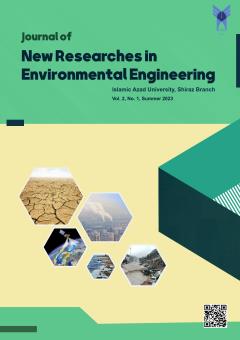Simultaneous Removal of Copper And Lead Metal Ions From Polluted Water Using Polymer Membrane Modified With Amorphous Silica Nanoparticles
Subject Areas : New technologies in natural resources and environmentBahareh Kamyabmoghadas 1 * , Nadia Tamimi 2
1 - Department of Chemical Engineering, Shiraz Branch, Islamic Azad University, Shiraz, Iran
2 - Department of Chemical Engineering, Shiraz Branch, Islamic Azad University, Shiraz, Iran
Keywords: Polymer membrane, polyethersulfone, nano silica, lead, copper, water pollution.,
Abstract :
Introduction: Heavy metals are one of the main water pollution in environmental problems. There are various methods to remove these pollutions, one of the best methods in this field is membrane processes. The purpose of this research is to remove heavy metals because they are toxic and have many harmful effects on the health of living organisms and the environment. For this purpose, modified polymer membranes were used, which can remove a large percentage of copper and lead ions dissolved in water at the same time. Materials and Methods: In this research, polyether sulfone polymer, N-dimethylacetamide solvent and amorphous silica nanoparticles were used as modifiers. The parameters of the experiment were polymer weight percentage (22-18-14%), nanoparticles weight percentage (0.0-0.1-0.2 weight percent of polymer) and pressure (12-17-22 bar). Results and Discussion: The optimal conditions obtained were 22% polymer membrane, 2% additives at 12 bar pressure, and the result of the test in these conditions was the removal of 74% and 82% of lead and copper, respectively. From the prepared membranes, Fourier transmission infrared spectroscopy (FTIR), scanning electron photography (SEM) and thermometric analysis (TGA) tests were performed. In FTIR analysis, peaks related to functional groups were determined. By examining the SEM test, the presence of silica nanoparticles in the polymer membrane was determined, and the TGA analysis in the modified membrane confirmed the increase in the thermal resistance of the membranes. Conclusion: According to the results obtained from the TGA test, it was found that the membrane modified with silica nanoparticles causes more delay in the degradation time, and the thermal resistance of the membranes modified with silica nanoparticles increases more, as a result, the presence of silica nanoparticles increases the stability of the membrane. According to the comparison and examination of the FT-IR test related to pure nanoparticles, pure polymer membrane and membranes with nanoparticles, in addition to identifying the peaks of the functional group of polyether sulfone polymer, the presence of the peak of silica nanoparticles in the modified membranes was also determined. that the presence of silica nanoparticles inside polyether sulfone polymer membranes was established.
[1] Vimonses V. Lei S. Jin Bo. Chris W. Chow K. 2009. Adsorption of congo red by three Australian kaolins. Chris Saint, Applied Clay Science. 43: 465.
[2] Daneshvar N. Salari D. Khataee A. 2003. Photocatalytic degradation of azo dye acid red 14 in water: investigation of the effect of operational parameters. J Photochem Photobiol A Chem
. 157(1): 111-6.
[3] Lu CS. Chen CC. Mai FD. Li HK. 2009. Identification of the degradation pathways of alkanolamines with TiO2 photocatalysis. J hazard mater. 165(1-3): 306-16.
[4] Fu F. Wang Q. 2011. “Removal of heavy metal ions from wastewaters A review”. Environmental Management¸ 92(3)¸ March¸ pp. 407-418.
[5] Farooq U. Kozinski J A. Khan M A. Athar M. 2001.“ Biosorption of heavy metal ions using wheat basedbiosorbents A review”. Bioresource Technology¸ 101¸pp. 5043-5053.
]6[ طیبان س م ر. ترابی ا. نجف پور ع ا. علیدادی ح. ززولی م ع. 1391. ”بررسی روش های بیو جذب فلزات سنگین کروم و کادمیوم از پساب های صنعتی با استفاده از زائدات کشاورزی (مطالعه موردی)“، مجله نوید نو، شماره 58.
[7] Wang J L. Chen C. 2006. “Biosorption of heavy metals bySaccharomyces cerevisiae: a reviewˮ. Biotechnology Advances¸ 24(5)¸ September-October¸pp. 427-451.
[10] Ahmad S. Ali A. Ashfaq A. 2016. “Heavy metal Pollution¸ Sources¸ Toxic Effects and Techniques Adopted for Controlˮ. International Journal of Current Research and Academic Review¸ 4(6)¸ pp. 39-58.
Ahmad S. Ali A. Ashfaq A. 2016. [9] Wang J. Chen C. 2009. “Biosorbents for heavy metals removal and their futureˮ . Biotechnology Advances¸ 27(2)¸ Marh-April¸ pp. 195-226.
[] Ghaemi, N., Zereshki, S., & Heidari, S. (2017). Removal of lead ions from water using PES-based nanocomposite membrane incorporated with polyaniline modified GO nanoparticles: Performance optimization by central composite design. Process Safety and Environmental Protection, 111, 475-490.
[] Yurekli, Y., 2016. Removal of heavy metals in wastewater by using zeolite nano-particles impregnated polysulfone membranes. Journal of hazardous materials, 309, pp.53-64.
[] Ghaemi, N., Madaeni, S. S., Daraei, P., Rajabi, H., Zinadini, S., Alizadeh, A., ... & Ghouzivand, S. (2015). Polyethersulfone membrane enhanced with iron oxide nanoparticles for copper removal from water: application of new functionalized Fe3O4 nanoparticles. Chemical Engineering Journal, 263, 101-112.
[] Daraei, P., Madaeni, S. S., Ghaemi, N., Salehi, E., Khadivi, M. A., Moradian, R., & Astinchap, B. (2012). Novel polyethersulfone nanocomposite membrane prepared by PANI/Fe3O4 nanoparticles with enhanced performance for Cu (II) removal from water. Journal of Membrane Science, 415, 250-259.
[] Mahmoud, M. E., Fekry, N. A., & El-Latif, M. M. (2016). Nanocomposites of nanosilica-immobilized-nanopolyaniline and crosslinked nanopolyaniline for removal of heavy metals. Chemical Engineering Journal, 304, 679-691.
[] Padmavathi, R., Minnoli, M., & Sangeetha, D. (2014). Removal of heavy metal ions from waste water using anion exchange polymer membranes. International Journal of Plastics Technology, 18(1), 88-99.
[16] Azizi, S., Jafarbeigi, E., & Salimi, F. (2023). Removal of heavy metals and dye from water and wastewater using nanofiltration membranes of polyethersulfone modified with functionalized iron-silica nanoparticles. Energy Sources, Part A: Recovery, Utilization, and Environmental Effects, 45(3), 6856-6868.
[17] Dadari, S., Rahimi, M., & Zinadini, S. (2022). Novel antibacterial and antifouling PES nanofiltration membrane incorporated with green synthesized nickel-bentonite nanoparticles for heavy metal ions removal. Chemical Engineering Journal, 431, 134116.

